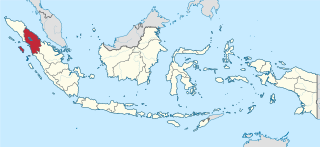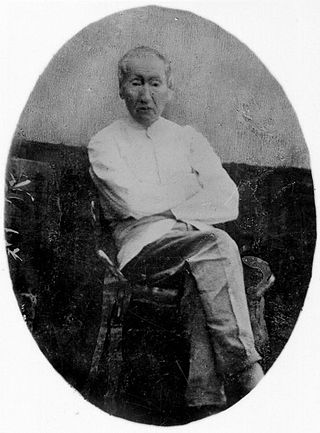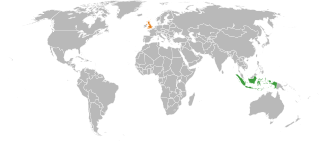
North Sumatra, also called North Sumatra Province, is a province of Indonesia located in the northern part of the island of Sumatra, just south of Aceh. Its capital and largest city is Medan on the east coast of the island. It is bordered by Aceh on the northwest and Riau and West Sumatra on the southeast, by coastlines located on the Indian Ocean to the west, and by the Strait of Malacca to the east.

Batak is a collective term used to identify a number of closely related Austronesian ethnic groups predominantly found in North Sumatra, Indonesia, who speak Batak languages. The term is used to include the Karo, Pakpak, Simalungun, Toba, Angkola, Mandailing and related ethnic groups with distinct languages and traditional customs (adat).

Ludwig Ingwer Nommensen was a Danish Lutheran missionary to Batak lands, North Sumatra who also translated the New Testament into the native Batak language and the first Ephorus (bishop) of Batak Christian Protestant Church. Stephen Neill, a historian of missions, considered Nommensen one of the greatest missionaries of all time. He is commemorated as a missionary on 7 November in the Calendar of Saints of the Lutheran Church with John Christian Frederick Heyer and Bartholomäus Ziegenbalg.

The Batak Christian Protestant Church abbreviated as HKBP, is an Evangelical Lutheran church among the Batak people, generally the Toba Batak in Indonesia. This church uses an Ecumenical worship style influenced by the Dutch Reformed Church due to the influence of Dutch colonialism in Indonesia, as well as the legacy obtained from the Rhenish Missionary Society when the church was founded. With a membership of 4,133,000, the church synod is the largest among the Protestant churches in Indonesia it is one of the largest Protestant churches in Indonesia and Southeast Asia, making it the third largest religious organization in Indonesia after Nahdlatul Ulama and Muhammadiyah. Its present leader is Ephorus (bishop) Victor Tinambunan.

Katharine Bushnell was a medical doctor, Christian writer, Bible scholar, social activist, and forerunner of feminist theology. Her lifelong quest was for biblical affirmation of the integrity and equality of women, and she published God's Word to Women as a correction of mistranslation and misinterpretation of the Bible. As a missionary and a doctor, Bushnell worked to reform conditions of human degradation in North America, Europe, and Asia. She was recognized as a forceful and even charismatic speaker.
The Rhenish Missionary Society was one of the largest Protestant missionary societies in Germany. Formed from smaller missions founded as far back as 1799, the Society was amalgamated on 23 September 1828, and its first missionaries were ordained and sent off to South Africa by the end of the year.

The Mandailing people are an ethnic group in Sumatra, Indonesia that is commonly associated with the Batak people. They are found mainly in the northern section of the island of Sumatra in Indonesia. They came under the influence of the Kaum Padri who ruled the Minangkabau of Tanah Datar. As a result, the Mandailing were influenced by Muslim culture and converted to Islam. There are also a group of Mandailing in Malaysia, especially in the states of Selangor and Perak. They are closely related to the Angkola and Toba.

Since the arrival of Christianity in China, the Bible has been translated into many varieties of the Chinese language, both in fragments and in its totality. The first translations may have been undertaken as early as the 7th century AD, but the first printed translations appeared only in the nineteenth century. Progress on a modern translation was encumbered by denominational rivalries, theological clashes, linguistic disputes, and practical challenges at least until the publication of the Protestant Chinese Union Version in 1919, which became the basis of standard versions in use today.

Christianity is Indonesia's second-largest religion, after Islam. Indonesia also has the second-largest Christian population in Southeast Asia after the Philippines, the largest Protestant population in Southeast Asia, and the third-largest Christian population in Asia after the Philippines and China. Indonesia also has the second-largest Christian population in the Muslim world, after Nigeria, followed by Egypt. Indonesia's 29.4 million Christians constituted 10.47% of the country's population in 2023, with 7.41% Protestant and 3.06% Catholic. Some provinces in Indonesia are majority Christian. In Indonesia, the word Kristen refers to Protestantism, while Catholicism is referred to as Katolik. In the 21st century the rate of growth and spread of Christianity has increased, especially among the Chinese minority.

Herman Neubronner van der Tuuk was a Bible translator and linguist specialising in the languages of the Dutch East Indies.
Characteristic of Christianity in the 19th century were evangelical revivals in some largely Protestant countries and later the effects of modern biblical scholarship on the churches. Liberal or modernist theology was one consequence of this. In Europe, the Roman Catholic Church strongly opposed liberalism and culture wars launched in Germany, Italy, Belgium and France. It strongly emphasized personal piety. In Europe there was a general move away from religious observance and belief in Christian teachings and a move towards secularism. In Protestantism, pietistic revivals were common.

Indonesia and the United Kingdom established diplomatic relations in 1949 and have maintained strong relations since then. Indonesia has an embassy in London while the United Kingdom has an embassy in Jakarta. The United Kingdom considers Indonesia an increasingly important partner globally and is committed to efforts to take bilateral relations to new heights. Both nations are members of G-20 major economies.

The Toba Batak people are the largest ethnic group of the Batak peoples of North Sumatra, Indonesia. The general term ‘Batak’ is sometimes used to refer to the Batak Toba people, for one thing because the Toba people are the largest sub-group of the Batak ethnicity, for another because they tend to self-identify as merely Batak instead of ‘Toba’ or ‘Batak Toba’, contrary to the habit of the Karo, Mandailing, Simalungun, Pakpak communities who commonly self-identify with their respective sub-groups.

Scottish Protestant missions are organised programmes of outreach and conversion undertaken by Protestant denominations within Scotland, or by Scottish people. Long after the triumph of the Church of Scotland in the Lowlands, Highlanders and Islanders clung to a form of Christianity infused with animistic folk beliefs and practices. From 1708 the Society in Scotland for Propagating Christian Knowledge (SSPCK) began working in the area. In 1797 James Haldane founded the non-denominational Society for the Propagation of the Gospel at Home. Dozens of lay preachers, divinity students and English preachers were sent to the region. In the early nineteenth century a variety of organisations were formed to support evangelism to the region.
The Methodist Church in Indonesia or GMI is a body within the Methodist tradition in Indonesia. GMI is jointly presided by two bishops, each representing the component annual conferences within the church.

Helen Beatrice de Rastricke Hanson was a British physician, missionary and suffragist.

Margaret Stephen Kennedy was one of the first zenana missionaries in India in the mid nineteenth century. She is most known for her ability to connect with people along all classes and races, her work for the London Missionary Society orphanage in Benares, contributing aid to a leper sanctuary in Almora, and providing an English and Biblical education to the Raja of Coorg’s daughter, Victoria Gouramma.

The Bible Society of Singapore, Malaysia and Brunei was a nondenominational Christian organisation committed to translating and distributing the Bible in Singapore, Malaysia, and Brunei. It was the successor organisation to the Bible Society of Malaya, a branch of the National Bible Society of Scotland (NBSS). The Bible Society of Malaya prior to 1948 was a branch of the British and Foreign Bible Society (BFBS).
Batak Muslims or Islamized Bataks refers to the Batak who embraced Islam as their religion. Historically, the Batak people practiced animism, with a strong emphasis on ancestral worship and other traditional beliefs. The transition to Islam among the Batak occurred gradually, with the early historical record started since at least 8th or 9th century, as a result of trade relations, missionary activities, and the influence of nearby Islamic-based monarchs in pre-colonial Indonesia.
Abdul Rasjid Siregar gelar Mangaradja Mahkota Soeangkoepon, commonly known as Dr. Abdul Rasjid, was a politician and physician in the Dutch East Indies. He was elected or appointed to the Volksraad from 1931 to 1942, during which time he sat with the Indonesian nationalist faction. During the 1930s, he became convinced that public health and cooperation with traditional healers should be central to the mission of physicians in the Indies.




















